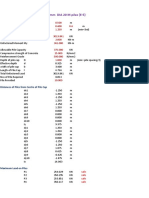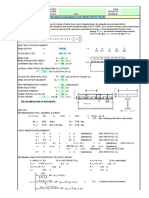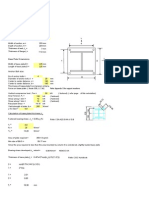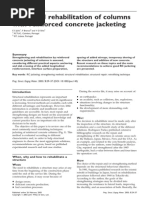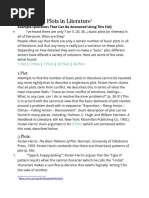0 ratings0% found this document useful (0 votes)
173 viewsRean'S Building 5/24/2002 Angle Plate Design: Framed Beam Connection
Rean'S Building 5/24/2002 Angle Plate Design: Framed Beam Connection
Uploaded by
rbalmodalThis document summarizes the design of a beam-to-column connection using angle plates. Key details include:
- The connection uses 4 bolts with 3" spacing to connect a W14x38 beam to 2L5x5x1/2" connection angles.
- Calculations check the bolt shear, bolt bearing, block shear capacity, and required angle and web plate thicknesses.
- The angle plate length is selected as 12.32" with a required thickness of 2mm to develop the bolt tension capacity without prying forces.
- Prying forces are considered and found to not govern the required plate thickness. The connection is designed to resist the 47.44 kip reaction
Copyright:
© All Rights Reserved
Available Formats
Download as XLS, PDF, TXT or read online from Scribd
Rean'S Building 5/24/2002 Angle Plate Design: Framed Beam Connection
Rean'S Building 5/24/2002 Angle Plate Design: Framed Beam Connection
Uploaded by
rbalmodal0 ratings0% found this document useful (0 votes)
173 views11 pagesThis document summarizes the design of a beam-to-column connection using angle plates. Key details include:
- The connection uses 4 bolts with 3" spacing to connect a W14x38 beam to 2L5x5x1/2" connection angles.
- Calculations check the bolt shear, bolt bearing, block shear capacity, and required angle and web plate thicknesses.
- The angle plate length is selected as 12.32" with a required thickness of 2mm to develop the bolt tension capacity without prying forces.
- Prying forces are considered and found to not govern the required plate thickness. The connection is designed to resist the 47.44 kip reaction
Original Description:
bearing plate design
Original Title
Bearing-P
Copyright
© © All Rights Reserved
Available Formats
XLS, PDF, TXT or read online from Scribd
Share this document
Did you find this document useful?
Is this content inappropriate?
This document summarizes the design of a beam-to-column connection using angle plates. Key details include:
- The connection uses 4 bolts with 3" spacing to connect a W14x38 beam to 2L5x5x1/2" connection angles.
- Calculations check the bolt shear, bolt bearing, block shear capacity, and required angle and web plate thicknesses.
- The angle plate length is selected as 12.32" with a required thickness of 2mm to develop the bolt tension capacity without prying forces.
- Prying forces are considered and found to not govern the required plate thickness. The connection is designed to resist the 47.44 kip reaction
Copyright:
© All Rights Reserved
Available Formats
Download as XLS, PDF, TXT or read online from Scribd
Download as xls, pdf, or txt
0 ratings0% found this document useful (0 votes)
173 views11 pagesRean'S Building 5/24/2002 Angle Plate Design: Framed Beam Connection
Rean'S Building 5/24/2002 Angle Plate Design: Framed Beam Connection
Uploaded by
rbalmodalThis document summarizes the design of a beam-to-column connection using angle plates. Key details include:
- The connection uses 4 bolts with 3" spacing to connect a W14x38 beam to 2L5x5x1/2" connection angles.
- Calculations check the bolt shear, bolt bearing, block shear capacity, and required angle and web plate thicknesses.
- The angle plate length is selected as 12.32" with a required thickness of 2mm to develop the bolt tension capacity without prying forces.
- Prying forces are considered and found to not govern the required plate thickness. The connection is designed to resist the 47.44 kip reaction
Copyright:
© All Rights Reserved
Available Formats
Download as XLS, PDF, TXT or read online from Scribd
Download as xls, pdf, or txt
You are on page 1of 11
REAN'S BUILDING 4-21 5/24/2002
Angle plate design:
Framed beam connection
Bearing type
lh
Q
lv
3"spacing
Notes:
Rbs = Resistance to block shear, kips
= 0.03AvFu + 0.50AtFu
= {(0.30lv + 0.50lh)+0.30[(n-1)(s- h)- h/2]- h/4}xFut
= (K1+K2)Fu tw
Where :
Av = Net shear area, sq. in.
At = Net tension area, sq. in.
Fu = Specified min. tensile strength, ksi
dh = dia. of hole ( dia. of fastener + 1/16"), in.
lh = distance center of hole to beam end, in.
lv = distance of center of hole to edge of web , in.
n = number of fasteners
s = Fastener spacing, in.
H = Depth of beam
Q = Coped dist. in.
Given:
Beam = W14 x 38
H = 14.1 in.
tf = 0.515 in.
tw = 0.310 in.
A36, Fy = 36 ksi
A36, Fu = 58 ksi
lv = ? in.
lh = 2 1/2 in.
Q = 3/4 in.
Beam reaction, P = 47.44 kips
A325-X Bolt dia. h = 3/4 in.
Hole dia.,dh = 13/16 in.
n = ? p s
(1.) Bolt Shear :
Area of 3/4 bolt, Ab = 0.442 sq.in.
Fv = 21.6 ksi
Single shear capacity.,Sv = AbFv 9.54 k/bolt
No. of bolt req'd.;r = P/(Sv*2) 2.49 pcs
Use n = 4 pcs
Bolt shear adequacy:
Allowable load for 3/4" A325x = 13.3 k > 9.54 k OK
Bolt strength at bolt holes on beam:
fv act. = (P/2n)/Ab
fv act. = 13.42 > 21.6 ksi OK
(2.) Bolt Spacing:
Minimum spacing = 2 2/3d = 2.00 in.
Prefferd spacing = 3d 2 2/8 in.
To satisfy bearing on web:
Spacing = (2P/Fut)+d/2 1.69 in.
Use standard, s 3.00 in.
(3.) Edge distance :
Minimum distance in the direction of raective force :
lv = 2P/Futw 0.53 in.
Use 1 1/2 in.
(4.) Check Shear & Tension (Block shear)
lv = 1.50 dh/2 = 0.41
lh = 2.50 dh/4 = 0.10
n-1 = 3 Fu = 58
s-dh = 2.19 tw = 0.95
dh = 0.81
0.3lv = 0.45
0.5lh = 1.25
(.3*lv+.5lh) = 1.7
(0.3((n-1)(s-dh)-dh/2))-dh/4= 1.75
Futw = 55.1
Allowable block shear, Rbs = 0.03AvFu + 0.50AtFu
= {(0.30lv + 0.50lh)+0.30[(n-1)(s- dh)- dh/2]- dh/4}xFutw
Rbs = 189.84 kips > P OK
Gross area of web plate = (H-(Q+tf))tw = 3.98 sq.in.
Net area of web plate,Anet = (H-(Q+tf+(dh*n)))tw = 2.97 sq.in.
Shear plate thickness for Block shear (Web):
H' = net length of plate
H' = (H-(Q+tf+(dh*n)) 9.59 in.
fv = 0.4Fy fv = P/Anet Anet=twH'
Required tw due to shear = 0.34 in. < 0.5 " OK
Net tension in web plate,T =
lh
Q
lv
S=3" H' M T
T = Tension in web plate due to Vert. Moment, M
M = from baseframe analysis (staad result)
M = 0.16 k-ft 1.92 k-in.
M = T * H'/2
T = 2M/H'
T = 0.40 kips
ft = 0.5Fy ft =T/(twH') tw =T/(ft*H')
Reqr'd tw due to mom. = 0.002 in. < 0.5" OK
(5.) Connection Angles:
width width thk. length
Try 2L 5 5 1/2 12.32 A36
Allowable bearing :
From Tabl I-F, for Fu = 58 ksi, lv = 1 1/2"
allowble load = 43.5 kips/hole
R = 174 kips > P OK
Shear on plane through fasteners:
allowble shear = 0.40Fy = 14.40 on gross area
0.30Fu = 17.4 on net area
net area governs when (d + 1/16")>L/6n
L = 12.32 in.
n= 4
(d+1/16")= 0.81 in.
L/6n = 0.513 in.
Net area = 2t[L-n(d+1/16)]
Net area, An = 9.07 sq.in.
fv = P/An
fv = 5.23 ksi < 0.3Fu
OK
USE 2L - 5" x 5" x 1/2" x 12.32" Connection angle
REAN'S BUILDING 5/24/2002
Beam bearing plate design:
N+2.5k
k
k1 k1 N
B
AISC - ASD
R = DL + LL = 33.17 k fc = 3 ksi
Fy = 36 ksi
W 14 X 53
k1 = 15/16 k = 1 7/16 tw = 3/8
bf = 8.06 tf = 0.66 h = 13.92
Allowable stresses:
Fb = 0.75fy 27 ksi
Fp = o.35f ' 1.05 ksi
A = R/Fb = 31.59 sq.in.
Let B = bf = 8.06 204.72 mm
N = A / B 3.919 in.
use N = 12 in.
304.8 mm
say 305 mm
Actual bearing pressure :
fp = R/(BxN) 0.343 ksi
n = (B/2)-k1 3.0925 in.
Calculate plate thikness:
t = ((3fpn^2/Fb))^.5
t = 0.604 in.
15.33 mm
say 16 mm
USE BEARING PLATE : 205 x 305 x 16 mm
Check web crippling on Lenght (N+2.5k)
@ Reaction:
R/(N+2.5k)tw < or = .75fy
R = 33.17 in.
N = 12.00 in.
2.5k = 3.59 in.
tw = 0.38 in.
R/(N+2.5k)tw = 5.67 <27 ksi OK
Check web crippling @ interior load:
N = 0.00 in.
Rn = 47.44 k
Rn = (N+5k)(Fyw)(tw)
Fyw = Rn/(N+5k)(tw)
Fyw = 17.60 <27 ksi OK
EUGENIO BUILDING 5/2/2002
Flange Thickness design:
Notation
T = factored applied tension per bolt, excluding initial tightening, kips
B = design tensile strength of bolt
Q = factored prying force per bolt at design load, kips
Fy = yield strength of flange
O = resistance factor
a = dimension shown in figure but to be takenin the analysis at not more than 1.25b
a', b, b' = dimension shown in figure
d = diameter of bolt
d' = width of bolt hole parallel to stem of tee
p = length of flange, parallel to stem, tributary to area of bolt
t = thickness of flange of tee
n = number of bolts
Ft = bolt capacity
A = section area of 1 bolt
M2 M2
M1 M1
2T a b 2T
a' b'
d
T+Q
T+Q T+Q Q
Q Q
Given: For W14 X 53
T = 32.4 kip-ft h = 13.92 in.
V = 0 kip bf = 8.06 in
Fy = 36 ksi tf = 0.66 in
N = 12 in. tw = 0.38 in
SELECTION OF T-STUB
Force in T-STUB, F = T = 32.40
Try n = 4 3/4 dia.Bolt,Ft = 90 kips
O = 0.75 A = 0.442 sq.in.
T = F/n = 8.10 kips
B = OFtA = 29.82 kips
p = N/2 = 6 in.
From equation: t = ((2tb')/(OFyp))^.5 assuming b'= 2.5 in
t = 0.46 in. 11.59 mm
Check Thickness:
1.25b = 3.59375 in.
b' = 2.5 in b = 2.875 in
a' = 3.8425 in >1.25b a = 4.2175 in
= (a'/b')((B/T)-1)
= 4.12 >1
use = 1 d' = 0.81
t^2 = (4.44Tb')/(pFy[1+ (1-(d'/p))])
4.44Tb' = 89.91
pFy = 216.00
1-(d'/p) = 0.87
t = 0.47 in. > 0.66 actual thikness OK
t = 12.00 mm. reqrd. thickness
say 12 mm.
REAN'S BUILDING 5/24/2002
Angle plate design:
Framed beam connection
Notation
T = Applied tension per bolt, excluding initial tightening & prying force, kips
Q = Prying force per bolt at design load, kips
B = Allowable tension per bolt, kips
tc = Flange or angle thickness required to develop B in bolts with no prying action, in.
= 8Bb'
pFy
Fy = Yield strength of flange material, ksi
p = length of flange, parallel to stem or leg, tributary to each bolt, in.
a = Distance from bolt centerline to edge of tee flange or angle leg more than 1.25b , in.
d = Bolt diameter, in.
d' = width of bolt hole parallel to stem tee stem or angle leg, in.
b' = b-(d/2), in.
a' = a+(d/2), in.
= b'/a'
n = number of bolts
Ab = section area of 1 bolt
N = Fitting length, in.
L = Length of angle plate
dx = Bolt location, in.
= (0< <1.0) ratio of moment at bolt line to mement at stem line
= M2/ M1
' = Value of for which required thickness (treq'd) is a minimum or allowable
applied tension per bolt (Tall) is a maximum.
= Ratio of net area (at bolt line) and a gross area (at the face of the stem or angle leg)
= 1-d'/p
M2 M2
M1 M1
2T a b 2T
a' b'
Web member
d
T+Q
T+Q T+Q Q
Q Q
Given:
From block shear calculation:
Connection Angles:
width width thk. length
Try 2L 5 5 1/2 12.32 A36
M = 0.16 kip-ft L = 12.32 in.
V = 47.44 kip dx = 5 in
Fy = 36 ksi tf = 0.5 in
L =N = 12.32 in. tw = 0.5 in
d = 3/4 in.
lh
Q
lv
3"spacing L M
SELECTION OF T-STUB
M = (L/2)*F
Force in T-STUB, F = 0.31 kip
B = 19.4 kips
n = T/B = 0.02 pcs
use n = 4 3/4 Ab = 0.442 sq.in.
T = F/n 0.08 <B OK
Bolt strength at bolt hole for tension:
ftall. = B/Ab ftact. = T/Ab ksi
= 43.91 > 0.2 OK
b = (dx-tw)/2 = 2.25 >1.25 in.
a = [(2w+tw)-dx]/2 2.75 in.
check 1.25b 2.81 > a
use 2.75 in.
b' = (b-d/2) 1.88 in.
a' = (a+d/2) 3.13 in.
p = L/2 = 6.16 in.
d' = d+1/16 0.8125 in.
= 1-d'/2 0.59 in.
= b'/a' 0.60
Calculate = 1/ ((B/T)-1)
if > 1 set ' = 1
if < 1 set ' = lesser of 1/ (( /1- )) and 1
= 413.28
use ' = 0.00
use ' = -1.69
Calculate Thickness, t required =
tc = 8Tb'
pFy(1+ ' )
8Tb' = 1.17
pFy = 221.76
' = 0.00
t = 0.07 < 0.5 OK
t = 1.84
say 2mm
Considering prying force:
tc = 8Tb'
pFy
tc = 0.07 < 0.5 OK
= 1/ [((T/B)/(t/tc)^2)-1]
if < 0 set = 0
1/ = 1.68
T/B = 0.00
(t/tc)^2 = 47.43
= -1.68
use = 0.00
Q = B (t/tc)^2
Q = 0.00 kips
You might also like
- PTSD Lesson PlanDocument8 pagesPTSD Lesson Plansp2056251No ratings yet
- Base Plate Design Is 800-2007Document6 pagesBase Plate Design Is 800-2007Suneesh P91% (11)
- Concrete Recycling - Research and PracticeDocument659 pagesConcrete Recycling - Research and Practicekarim hassanNo ratings yet
- Basement Concrete Wall Design Based On ACI 318-19: Input Data & Design SummaryDocument2 pagesBasement Concrete Wall Design Based On ACI 318-19: Input Data & Design SummaryErielle AngelaNo ratings yet
- Wind Load and Roof Load CalculationDocument20 pagesWind Load and Roof Load Calculationleodegarioporral0% (1)
- 4 Storey Apartment BuildingDocument2 pages4 Storey Apartment BuildingrbalmodalNo ratings yet
- 4 Storey Apartment BuildingDocument2 pages4 Storey Apartment BuildingrbalmodalNo ratings yet
- Product Realization Process - MapDocument1 pageProduct Realization Process - Mapsenthildurai0% (1)
- Superstitions: A Culturally Transmitted Human Behavior: January 2018Document6 pagesSuperstitions: A Culturally Transmitted Human Behavior: January 2018minecraft opNo ratings yet
- End Plate Moment ConnectionDocument4 pagesEnd Plate Moment Connectionmahhor82_635643838No ratings yet
- Hongo India PVT LTD (Frame-1) : Bolt Moment ConnectionDocument1 pageHongo India PVT LTD (Frame-1) : Bolt Moment Connection4geniecivilNo ratings yet
- W14x43 To HSS6x6x1 - 2 Moment ConnDocument21 pagesW14x43 To HSS6x6x1 - 2 Moment ConnrajedmaglinteNo ratings yet
- Connections I V2.1.0.a1Document49 pagesConnections I V2.1.0.a1gissel vicencioNo ratings yet
- BASEPLT9Document27 pagesBASEPLT9Homero Silva100% (3)
- AISC 13ed - LRFD Bolted Moment Connections Post r4Document613 pagesAISC 13ed - LRFD Bolted Moment Connections Post r4jh50000No ratings yet
- Cranebeam v1 2 AramadaDocument1 pageCranebeam v1 2 AramadaronyNo ratings yet
- Anchor Bolt (CSA) Rev1.1Document10 pagesAnchor Bolt (CSA) Rev1.1coolkaisyNo ratings yet
- Base PlateDocument2 pagesBase PlateLam TranNo ratings yet
- Anchorbolt (318 08) ShearDocument1 pageAnchorbolt (318 08) ShearAnonymous xcFcOgMiNo ratings yet
- Do's and Don'Ts For Eq Resistant Design of BuildingsDocument44 pagesDo's and Don'Ts For Eq Resistant Design of BuildingsPraveen Gavad100% (1)
- ConnectionDocument7 pagesConnectionasad_naqviNo ratings yet
- AISC Properties ViewerDocument1 pageAISC Properties ViewerAulia MirzaNo ratings yet
- Wall - Shear Rebar Design - SumanDocument2 pagesWall - Shear Rebar Design - Sumansuman_civil100% (1)
- Aisc 28Document4 pagesAisc 28Ramesh SahasrabudheNo ratings yet
- Aisc 20Document11 pagesAisc 20Deny SitorusNo ratings yet
- Design of Restrained Slab (Bs 8110) : Mid-SpanDocument4 pagesDesign of Restrained Slab (Bs 8110) : Mid-SpanMwengei MutetiNo ratings yet
- The - Thickness - of - Base - Plate - by - The - LRFD - The - I - Section Column - and - ConcreteDocument9 pagesThe - Thickness - of - Base - Plate - by - The - LRFD - The - I - Section Column - and - ConcretejscuencaNo ratings yet
- 4.3 Design of Base Plate W STIFFENER (Feb 21 2015)Document54 pages4.3 Design of Base Plate W STIFFENER (Feb 21 2015)MuhammadIqbalMughalNo ratings yet
- Bracket - 4 DesignDocument1 pageBracket - 4 Designbjreddy100% (2)
- Connection Design For Column Above Beam, Based On AISC Manual & AISC 360-05Document1 pageConnection Design For Column Above Beam, Based On AISC Manual & AISC 360-05RayodcNo ratings yet
- Concrete Diaphragm In-Plane Shear Design Based On ACI 318-19Document1 pageConcrete Diaphragm In-Plane Shear Design Based On ACI 318-19Niky OrtegaNo ratings yet
- "Weldgrp" - Weld Group Analysis ProgramDocument16 pages"Weldgrp" - Weld Group Analysis ProgramMario BertiNo ratings yet
- One Way+ Two Way Joist System SafiDocument71 pagesOne Way+ Two Way Joist System SafiUmair RazaNo ratings yet
- CHS-rounded Hollow Section DesignDocument2 pagesCHS-rounded Hollow Section DesigntamerragaaNo ratings yet
- Monorail 0.5 TonDocument9 pagesMonorail 0.5 TonAndreas HendiNo ratings yet
- "Shear-End-Pl-13" - Beam End Connection Using Shear End PlatesDocument16 pages"Shear-End-Pl-13" - Beam End Connection Using Shear End PlatesArdXkillerNo ratings yet
- SteelDesign Composite Fu NewDocument16 pagesSteelDesign Composite Fu Newpresentasi mankonNo ratings yet
- Diaphragm CalculatorDocument24 pagesDiaphragm CalculatorNameNo ratings yet
- ACI-350 P-M Interaction 2.1Document33 pagesACI-350 P-M Interaction 2.1corneliortizNo ratings yet
- Design CalcDocument9 pagesDesign CalcMuhammad Hasan100% (1)
- Sleeve Joint Connection Design, For Steel Cell Tower / Sign, Based On AISC 360-10 Input Data & Design SummaryDocument2 pagesSleeve Joint Connection Design, For Steel Cell Tower / Sign, Based On AISC 360-10 Input Data & Design SummaryAmey Gudigar100% (1)
- I. Calculation of Loads: Design of Bottom Chord Bracing & Tie Runner: 1.analysisDocument12 pagesI. Calculation of Loads: Design of Bottom Chord Bracing & Tie Runner: 1.analysisRaviKiranNo ratings yet
- Pile Cap 10 PileDocument3 pagesPile Cap 10 PileShashankSinghNo ratings yet
- Daniel Tian Li: Input DataDocument11 pagesDaniel Tian Li: Input DataAmey GudigarNo ratings yet
- LRFD Composite Beam DesignDocument1 pageLRFD Composite Beam DesignAlvaro Garnica TrujilloNo ratings yet
- Hori-Bracing Connection Design 4 BoltsDocument22 pagesHori-Bracing Connection Design 4 BoltsUmer AziqNo ratings yet
- CivilBay Engineering XXX Design Project Shear Connection Shear-1 PDFDocument9 pagesCivilBay Engineering XXX Design Project Shear Connection Shear-1 PDFhemantcabhaleNo ratings yet
- Beam On Elastic Foundation-Finite ElementDocument29 pagesBeam On Elastic Foundation-Finite ElementrymacNo ratings yet
- Tedds Calculation Version 1.0.04: I I I 1 I I 2Document2 pagesTedds Calculation Version 1.0.04: I I I 1 I I 2Supun Aravinda JayawardhaneNo ratings yet
- Chapter 3 - SP17 - 09-07 - Excluding MP Diagrams - PDFDocument17 pagesChapter 3 - SP17 - 09-07 - Excluding MP Diagrams - PDFMD. NASIF HOSSAIN IMONNo ratings yet
- Ductile Detailing of Beam As Per IS 13920Document4 pagesDuctile Detailing of Beam As Per IS 13920Civil Funda100% (1)
- Beam - Deflection CheckDocument8 pagesBeam - Deflection ChecksharanekkmNo ratings yet
- W18X46 W3-7 1/2" NW 30 10 106: The Beam Design Is AdequateDocument7 pagesW18X46 W3-7 1/2" NW 30 10 106: The Beam Design Is Adequateஅம்ரு சாந்திவேலுNo ratings yet
- Design of FootingDocument15 pagesDesign of FootingRumylo AgustinNo ratings yet
- Design of Isolated Foundation - 13Document1 pageDesign of Isolated Foundation - 13Srinivasa RaoNo ratings yet
- DBR KolkataDocument17 pagesDBR Kolkatazoha jafarNo ratings yet
- Building - B: Vertical Haunch Conn Along Line-A & B: Mark:-NONEDocument18 pagesBuilding - B: Vertical Haunch Conn Along Line-A & B: Mark:-NONEmaheshbandhamNo ratings yet
- BMREINF13Document50 pagesBMREINF13NEO100% (1)
- Larsen & Toubro Limited: ECC Division - EDRCDocument1 pageLarsen & Toubro Limited: ECC Division - EDRCGanesh PrabuNo ratings yet
- SSE RC Corbel Designer - EC2v1 - 11 - TM-GB-G9-5 - 20211023 - 1952 - 45Document1 pageSSE RC Corbel Designer - EC2v1 - 11 - TM-GB-G9-5 - 20211023 - 1952 - 45SES DESIGNNo ratings yet
- Rean'S Building 5/24/2002 Angle Plate Design: Framed Beam ConnectionDocument11 pagesRean'S Building 5/24/2002 Angle Plate Design: Framed Beam Connectionmhel_almoNo ratings yet
- AISC Tension MemberDocument3 pagesAISC Tension Membermodulor3dNo ratings yet
- Corbel DesignDocument3 pagesCorbel DesignManoj JaiswalNo ratings yet
- Section Size: W200X36: Refer Appendix D For Support ReactionsDocument10 pagesSection Size: W200X36: Refer Appendix D For Support Reactionsramuce04No ratings yet
- Desiner 88.6Document28 pagesDesiner 88.6ramin005No ratings yet
- Base Plate Design - BS CodeDocument3 pagesBase Plate Design - BS Codemicheleling669660% (5)
- Shear Connections Notes: (1) The Beams Considered With Coped ConditionDocument9 pagesShear Connections Notes: (1) The Beams Considered With Coped ConditionSrikanth SikhaNo ratings yet
- Technical SpecificationsDocument16 pagesTechnical SpecificationsrbalmodalNo ratings yet
- CH 20Document9 pagesCH 20Iver LopezNo ratings yet
- SeismicProvisionsofASCE7 05part3Document59 pagesSeismicProvisionsofASCE7 05part3yangmeme320% (1)
- 1000MT Cap DesignDocument5 pages1000MT Cap Designrbalmodal100% (1)
- Shear Wall Design DetailDocument1 pageShear Wall Design DetailrbalmodalNo ratings yet
- Cant FTGDocument1 pageCant FTGrbalmodalNo ratings yet
- Use Section:: Steel Purlin DesignDocument1 pageUse Section:: Steel Purlin DesignrbalmodalNo ratings yet
- Block 5 Oneway Slab Design : Consider 1ft. WidthDocument3 pagesBlock 5 Oneway Slab Design : Consider 1ft. WidthrbalmodalNo ratings yet
- Tiarra: Twoway Slab Design Ls M FTDocument4 pagesTiarra: Twoway Slab Design Ls M FTrbalmodalNo ratings yet
- Col.1 A B A/2 b/2Document3 pagesCol.1 A B A/2 b/2rbalmodalNo ratings yet
- Finite Element Study of Using Concrete Tie Beams To Reduce Differential Settlement Between FootingsDocument5 pagesFinite Element Study of Using Concrete Tie Beams To Reduce Differential Settlement Between FootingsrbalmodalNo ratings yet
- Girder 1Document80 pagesGirder 1rbalmodalNo ratings yet
- Electrical PlansDocument4 pagesElectrical Plansrbalmodal100% (1)
- Structural ComputationDocument59 pagesStructural Computationrbalmodal88% (8)
- Sanacija AB KonstrukcijaDocument9 pagesSanacija AB KonstrukcijaMilos DjukicNo ratings yet
- Sexually Transmitted DiseasesDocument30 pagesSexually Transmitted Diseasesmohd ameerNo ratings yet
- The Basic Plots in LiteratureDocument4 pagesThe Basic Plots in LiteratureStephen Hague100% (1)
- FRP Ladder Catalouge With Price ListDocument5 pagesFRP Ladder Catalouge With Price ListSubhadip RoyNo ratings yet
- Dlo RHH RHW-2 RW90-2000VDocument1 pageDlo RHH RHW-2 RW90-2000VSalvatierra Rojas MoisesNo ratings yet
- (Ang Bundok Sa Radial Road 10) Cachola, Aleli May v. Gen. Vicente Lim EsDocument10 pages(Ang Bundok Sa Radial Road 10) Cachola, Aleli May v. Gen. Vicente Lim EsLei AlegreNo ratings yet
- International MasterDocument21 pagesInternational MasterminhbmtsNo ratings yet
- Performance Study of Vmware Vstorage Thin ProvisioningDocument14 pagesPerformance Study of Vmware Vstorage Thin ProvisioningChristian Joel SaizNo ratings yet
- Fish Classification, StructureDocument40 pagesFish Classification, StructureBio SciencesNo ratings yet
- Squad Leader Core Rules PDFDocument283 pagesSquad Leader Core Rules PDFMemphisBlood100% (4)
- Exampro GCSE Chemistry: C3 Chapter 4 HigherDocument37 pagesExampro GCSE Chemistry: C3 Chapter 4 HigherAayma MunirNo ratings yet
- 2008 - Nairne PandeiradaDocument9 pages2008 - Nairne PandeiradaLunaNo ratings yet
- Poly (Meth) Acrylate Based CoatingsDocument9 pagesPoly (Meth) Acrylate Based CoatingssuryaprakashreddycNo ratings yet
- Racing 150 (SE30BA)Document124 pagesRacing 150 (SE30BA)Mario KnochNo ratings yet
- Skydeals - BOQ - BNEDocument14 pagesSkydeals - BOQ - BNENishant MishraNo ratings yet
- Flow Analyses Inside Jet Pumps Used For Oil WellsDocument11 pagesFlow Analyses Inside Jet Pumps Used For Oil WellsAamir SultanNo ratings yet
- Customer Service-Troubleshooting Manual For RechargeDocument16 pagesCustomer Service-Troubleshooting Manual For RechargeJack WardenNo ratings yet
- RAN14.0 Introduction v11Document171 pagesRAN14.0 Introduction v11Swandito HaryoyudantoNo ratings yet
- Protastructure Design Guide Column Design Verification by N M Interaction DiagramDocument20 pagesProtastructure Design Guide Column Design Verification by N M Interaction Diagramchong fung yunNo ratings yet
- Counter Manual Rev2Document8 pagesCounter Manual Rev2Yuvaraj muthukrishnanNo ratings yet
- Key Points: Silver Diamine FluorideDocument12 pagesKey Points: Silver Diamine FluorideFFDFNo ratings yet
- Vista Explodida Modelos 12 A 48Document22 pagesVista Explodida Modelos 12 A 48Caio Guarnieri DuarteNo ratings yet
- List of Companies in ShippingDocument57 pagesList of Companies in ShippingDilip VishwakarmaNo ratings yet
- XTR 117Document24 pagesXTR 117rashidNo ratings yet
- Thermo Siphon Vessel S-S3H3-2040-X001Document3 pagesThermo Siphon Vessel S-S3H3-2040-X001Luis Armando Fariñas CarvajalNo ratings yet
- MAN B&W Slide Fuel ValveDocument1 pageMAN B&W Slide Fuel ValveKanushkaPradeepBandaraThennakoonNo ratings yet
- User Guide Nokia 2720 User GuideDocument38 pagesUser Guide Nokia 2720 User GuideOwen DhliwayoNo ratings yet









































